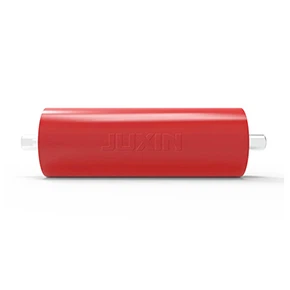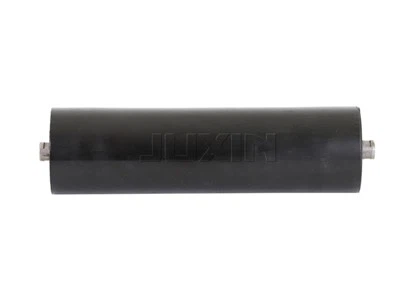Conveyor belt pulleys are the critical power-transmission components in bulk handling systems. Acting as the "engine" of conveyors, they drive, redirect, and tension belts to transport materials efficiently.
Conveyor pulleys are the powerhouse of belt conveyor systems, converting motor torque into belt motion through controlled friction.
Conveyor Pulley Parts

A standard conveyor pulley comprises three critical conveyor pulley components:
- Shell: Cylindrical surface contacting the belt, made of carbon/stainless steel for load bearing.
- End Discs: Welded to shell ends to resist structural deformation under high tension.
- Shaft & Bearings: Precision-machined shafts (e.g., 42CrMo alloy) with sealed bearings minimize rotational friction.
Should you wish to acquire more knowledge regarding conveyor parts, kindly refer to my new article.
Understanding types of pulleys used in belt drive systems is essential for optimizing conveyor efficiency. As leading belt conveyor drum pulley manufacturers, we'll decode key pulley types for global operations.
Types of Pulleys in a Conveyor Belt

Conveyor Head Pulley |
Position The head drive pulley is strategically positioned at the discharge end of the conveyor system. Function The fundamental role of the head pulley in conveyor systems is to transmit motor power to the belt via controlled friction. Unique Design Lagging Options: Diamond-grooved rubber enhances the friction coefficient by 30% vs. smooth surfaces, critical for steep-incline conveyors. Torque Capacity: Mining-grade head drive pulleys withstand up to 500 kN·m torque – equivalent to lifting 50 sedans simultaneously. Driving Force Provision: Be Larger in diameter than tail pulleys/ snub pulleys in the conveyor belt system and designed to rotate at a higher speed. Principle Motor-driven shaft rotates the shell, propelling the belt forward. |
 |
Conveyor Tail Drum |
Position The tail drum pulley is strategically positioned at the loading end of the conveyor. Function The fundamental role of tail drum pulley is to guide belt return and maintain tension. Critical Features Self-cleaning design: Tail drum pulley can prevent material buildup. Shaft protection: Dust seals extend bearing life 2X. Bearing: Tail drum pulley feature internal bearings or be supported by external bearings. |
 |
Conveyor Take Up Pulley |
Position The conveyor take up pulley is positioned along the return run. Structure The conveyor take up pulley structure features counterweighted or screw-actuated systems. It is mounted on a sliding base for ±300mm travel. Function The conveyor take up pulley functions to manually or automatically compensate for belt stretch, temperature changes, or wear – via gravity or mechanical systems. Benefit The conveyor take up pulley prevents belt sag and ensures the belt maintains optimal tension: tight enough to prevent slippage on the drive pulley and sagging between idlers, yet not so tight as to cause excessive stress. It is essential for balanced system operation. |
 |
Conveyor Snub Pulley |
Position The conveyor snub pulley is strategically positioned adjacent to head pulley. Role Conveyor snub pulley increases the belt's contact arc or wrap angle around the drive pulley. By forcing the belt to hug the drive pulley more tightly, it dramatically improves traction and power transmission efficiency. Benefit Conveyor snub pulley boosts traction by 25%, reducing drive power. It helps prevent belt slip, especially under heavy loads or in challenging start-up conditions. |
 |
Conveyor Bend Pulley |
Position Found in various locations-such as before the loading zone, after the discharge, or where the conveyor structure changes elevation-conveyor bend pulley smoothly alter the belt's trajectory. Role Conveyor bend pulleys redirect the belt's path wherever necessary smoothly. Benefit Conveyor bend pulley minimize belt stress at directional changes, and ensure the belt stays properly aligned onto subsequent idlers or pulleys. |
 |
Wing Pulley |
Position The wing tail pulley is strategically positioned at the loading end of conveyor. Role The wing tail pulley can help to guide the belt ,prevent it from slipping off the pulley and reduce material jamming. Benefit The wing tail pulley can improve the tracking of the belt, which can reduce wear and tear on the belt and other conveyor components.Wing tail pulleys reduce buildup by 90%. |
 |
Maximizing Value Through Precision Selection
All conveyors consist of at least two pulleys, and none of the conveyor pulleys can accommodate all the product types.Juxin's product types can meet the needs of the vast majority of scenarios. However, if none of our products suit your requirements, our engineers can design customized drum pulley for conveyor belt. As the leading belt conveyor drum pulley manufacturers, we will help you choose the most suitable and cost-effective conveyor pulleys for you. Please contact our professionals for more information and make the wisest decision.
Related articles






